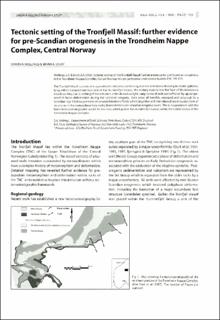| dc.contributor.author | Wellings, Simon | |
| dc.contributor.author | Sturt, Brian | |
| dc.coverage.spatial | 16193 Alvdal | |
| dc.coverage.spatial | 16192 Tylldal | |
| dc.coverage.spatial | TYNSET | |
| dc.coverage.spatial | ALVDAL | |
| dc.date.accessioned | 2020-08-26T09:01:30Z | |
| dc.date.available | 2020-08-26T09:01:30Z | |
| dc.date.issued | 1998 | |
| dc.identifier.uri | https://hdl.handle.net/11250/2674083 | |
| dc.description.abstract | The Tronfjell Massif consists of layered mafic intrusion, containing dunites and olivine-bearing to noritic gabbros, lying within metasedimentary rocks of the Hummelfjell Group. The initially more or less flat form of the intrusion is now bowl-like, due to settling of the intrusion under its own weight. Large areas of rock were affected by upper greenschist-facies deformation during the Scandian orogeny. Rare areas of hornfels, wrapped an dcross-cut by a Scandian-age foliation, preserve an annealed tectonic fabric which, together with the inferred pre-intrusion form of structures in the metasedimentary rocks, demonstrate a pre-Scandian orogenic event. This is in agreement with the latest tectonostratigraphic model for the area, which places the Hummelfjell group within the Heidal Group of the Trondheim Nappe complex | |
| dc.language.iso | eng | |
| dc.relation.ispartofseries | NGU Bulletin (434) | |
| dc.rights | Navngivelse 4.0 Internasjonal | |
| dc.rights.uri | http://creativecommons.org/licenses/by/4.0/deed.no | |
| dc.subject | STRATIGRAFI | |
| dc.subject | TEKTONIKK | |
| dc.subject | OMVANDLING | |
| dc.title | Tectonic setting of the Tronfjell Massif ; further evidence for pre-Scandian orogenesis in the Trondheim Nappe Complex, Central Norway. | |
| dc.type | Journal article | |
| dc.description.localcode | 49128 | |
| dc.source.pagenumber | 109-115 | |

